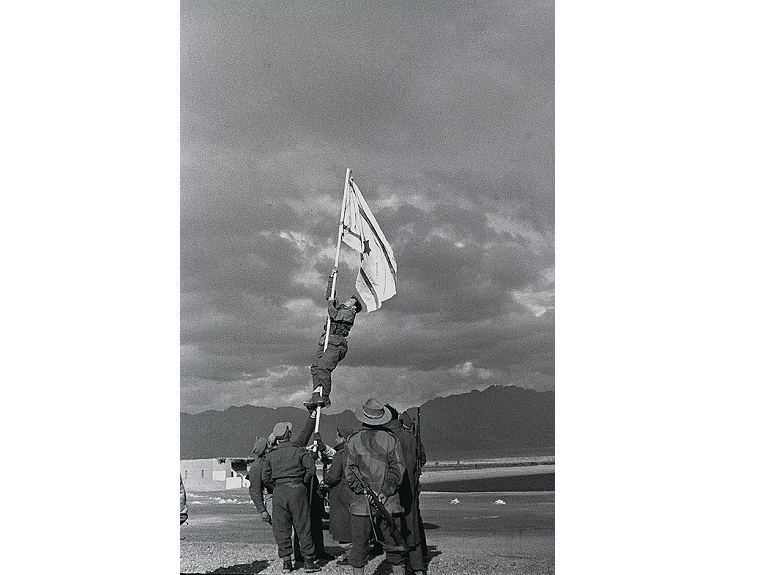(Cover image Credit: Micha Perry / IDF Spokesperson’s Unit)
The Israeli War of Independence is a story about bravery. A story about sacrifice. And a story of creation, of realizing an ancient dream – one that is almost 2000 years old.
This is the story of the birth of the State of Israel.
- Introduction
- The First Phase of the Israeli War of Independence – 29 November 1947 – 1 April 1948
- The Second Phase of the Israeli War of Independence – 1 April – 15 May 1948
- The Third Phase of the Israeli War of Independence – 15 May – 19 July 1948
- The Fourth Phase of the Israeli War of Independence – 19 July 1948 – 20 July, 1949
- Aftermath and Summary
Introduction
Let’s go back in time. The year is 1947. The sound barrier has just been broken, the CIA is established and Ferrari begins production of Italian sports cars.
And on November 29th, 1947, a paramount event takes place. The General Assembly of the United Nations votes on whether to end the British Mandate over Palestine (aka the Land of Israel) and partition the land into two new states – a Jewish state and an Arab state.
The suspense is immense. Every Jewish person living in Palestine sits near a radio, carefully listening. Every vote can make the difference. Every vote can crush the dream.
The vote begins. Afghanistan – against. Argentina – abstained. Australia – for. And it goes on and on. Finally, 33 states vote for the resolution, 13 against and 10 abstained.
The resolution is adopted!
The British Mandate is to end by August 1st 1948, and a Jewish state and Arab state will come into existence two months after the British withdrawal, but no later than 1 October 1948.
And for Jerusalem? Since both Palestinian nationalists and Jewish nationalists (known as Zionists) want Jerusalem to be their own, the UN decides on a Special International Regime for the city of Jerusalem.

The Jews are ecstatic. After all they have been through – exile, destruction of the temples, anti-Semitism, the horrible holocaust – finally, they will live as a free nation in their own state.
What do they do? They celebrate in the streets! Parades are held, and spontaneous dancing takes place. Israel is about to be real!
How do the Arabs respond? Arab leaders and governments reject the resolution. They refuse to accept any form of territorial division.
The Arab people living in Palestine (later known as Palestinians) are mad. Furious. They decide to defy the UN resolution and prevent the partition by force.
The Palestinians immediately start attacking Jews. Arab mobs attack Jewish quarters in Jerusalem and Arab irregulars begin operations against Jewish cities and settlements.
The first casualties are passengers on a Jewish bus driving on the Coastal Plain near Kfar Sirkin on 30 November 1947. An eight-man Arab gang from Jaffa ambushed the bus killing five and wounding others. Half an hour later they ambushed a second bus, southbound from the city of Hadera, killing two more. Arab snipers also attack Jewish buses in Jerusalem and Haifa.
The War of Independence has begun.
Well, actually, it is only the first phase of the War of Independence that has begun. See, this war is one of the longer wars that took place in Israel, and for the Israelis it is also the deadliest (but we’ll get there).
The First Phase of the Israeli War of Independence
This first phase is known as the 1947-1948 Civil War in Mandatory Palestine.
In this phase (29 November 1947 – 1 April 1948), it is the Palestinian Arabs who take the offensive, with the help of volunteers from neighboring countries; the Jewish residents in the land of Israel (known as Yishuv, settlement) have little success in limiting the war.
The Yishuv suffers severe casualties and disruption of passage along most of the major highways.
In the last week of March alone, the losses sustained by the largest Jewish underground movement Haganah are particularly heavy: they lose three large convoys in ambushes, more than 100 soldiers as well as their fleet of armored vehicles.
To make things worse, West Jerusalem is gradually ‘choked’ under an Arab siege. You have to remember that at this point 100,000 Jews live in Jerusalem – which means that one sixth of the Jewish population is under Arab siege!
And in the north, the settlements of Galilee could not be reached in any other way but via the valley of Jordan and the road of Nahariya.

If all of this isn’t enough, the plot thickens. The British are planned to leave Palestine in May, leaving a void. This void is about to be filled by a coordinated attack of all the Arab states surrounding Israel.
It is time for the Jews of the Yishuv to step up their game.
It is time to take the wheel.
It is time for phase 2 – the Jews strike back!
The Second Phase of the Israeli War of Independence
The second phase is relatively short, only six weeks long – it takes place on 1 April – 15 May 1948.
During this time, the Haganah takes the initiative, and turns the tables – capturing, among other things, the Arab sections of Tiberias, Haifa and later also Safed and Acre, temporarily opening the road to Jerusalem and gaining control of much of the territory allotted to the Jewish State under the UN Resolution.
This is all possible due to Operation Balak – a smuggling operation that took place during March. In this operation, the Jews managed to purchase arms in Europe while avoiding (or bypassing) various embargoes and boycotts. These boycotts were meant to prevent the Jews from transferring the arms to the Yishuv. Seems a bit unfair, as the Arabs had unlimited supplies from their allies in the surrounding Arab states…
The shipment of thousands of rifles and hundreds of machine guns allowed the Haganah to supply weapons for the concentrated effort of the second phase.
A monumental event happens on 14 May 1948. An event for which Jews have prayed for 2000 years. An event long awaited for.
On this day, the State of Israel is proclaimed as British mandate over Palestine ends at midnight.
In one of his most important and memorable speeches, David Ben Gurion said:
“By the virtue of our historical and natural right
and based on United Nations General Assembly resolution
We hereby declare on the establishment of a Jewish state in the Land of Israel – the State of Israel”
David Ben Gurion went on to be the first Prime Minister of the State of Israel.
You can see some of the highlights of this moving historic moment here:
Both superpower leaders, U.S. President Harry S. Truman and Soviet leader Joseph Stalin, immediately recognised the new state.
So it is official. Israel is real! It only needs to survive the fierce fighting first…
The Third Phase of the Israeli War of Independence
This phase, between 15 May – 19 July 1948, is considered by many to be the critical phase.
In this phase, the fight stopped being a civil war.
Why?
Since it is not only Palestinians vs Jews anymore. Now, the Arab armies enter the scene.
Over the next few days, four of the seven countries of the Arab League invade the former British Mandate of Palestine and fight the Israelis.
That’s right, now the Israelis have to fight off soldiers from Egypt, Iraq, Transjordan, and Syria, supported by the Arab Liberation Army and corps of volunteers from Saudi Arabia, Lebanon and Yemen. Yes, you read that right.
The Arab armies launch a simultaneous offensive on all fronts: Egyptian forces invade from the south, Jordanian and Iraqi forces from the east, and Syrian forces invade from the north.
The Arab armies have an overwhelming superiority of heavy equipment – armor, artillery and air force.

The first test of the Israeli State is a fateful one.
In May the Israel Defense Forces (IDF) is born as the official military forces of the State of Israel. It replaces all of the underground movements that exist at the time (Haganah was the largest one, but not the only one).
The IDF suffers initial setbacks, including the loss of the Etzion Bloc in Judea, the area of Mishmar Hayarden in the north and Yad Mordechai in the south, but after three weeks it is able to halt the offensive, stabilize the front and even initiate some local offensive operations.
The Fourth Phase of the Israeli War of Independence
The fourth phase (and the last one) is also the longest – 19 July 1948 – 20 July, 1949.
In this phase, Israel takes the initiative and goes on several large operations: Operation Yoav, in October, cleared the road to the Negev desert, culminating in the capture of Be’er Sheva; Operation Hiram, at the end of October, resulted in the capture of the Upper Galilee; Operation Horev in December 1948 and Operation Uvda in March 1949, completed the capture of the Negev, which had been allotted to the Jewish State by the United Nations.
In this phase, the Arab countries sign Armistice Agreements. The first to sign is Egypt – 24 February 1949; followed by Lebanon – 23 March; Jordan – 3 April; and Syria – 20 July. Only Iraq did not sign an armistice agreement with Israel. It preferred to withdraw its troops and hand over its sector to the Arab Legion of Jordan.
Aftermath and Summary
So what is the aftermath? What are the consequences?
- The armistice lines see Israel holding about 78% of mandate Palestine (as it stood after the independence of Transjordan in 1946), 22% more than the UN Partition Plan had allocated.
- These ceasefire lines are known as the “Green Line”.
- Gaza strip is occupied by Egypt, the West Bank is occupied by Transjordan (so unlike the current narrative, these territories were never occupied from the Palestinians by Israel – they were first held by Egypt and Transjordan, and later on by Israel).
- Israel lost 6,373 of its people, or about 1% of its population, in the war. This is a monumental number of people to lose in one war, compared to the size of the population.
- The exact number of Arab losses is unknown but is estimated at between 4,000 and 15,000.
- Around 700,000 Palestinian Arabs fled or were expelled. This creates the Palestinian refugee problem and the debate around the right of their return, which are major issues of the Israeli–Palestinian conflict to this day.
- The war indirectly creates another major refugee problem, the Jewish exodus from Arab and Muslim lands. Partly because of the war between Jews and Arabs in Palestine, hundreds of thousands of Jews who lived in the Arab states were intimidated into flight, or were expelled from their native countries, most of them reaching Israel. The immediate reasons for the flight were the popular Arab hostility, including pogroms, triggered by the war in Palestine and anti-Jewish governmental measures. In the three years following the war, about 700,000 Jews immigrated to Israel from Muslim countries.
That is it, the Israeli War of Independence is finally over. The State of Israel makes it through its first ferocious test, through its first fight for life – and emerges victorious.
At long last, the State of Israel is finally real!

